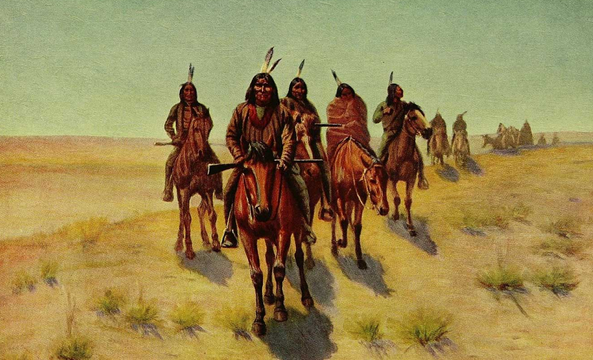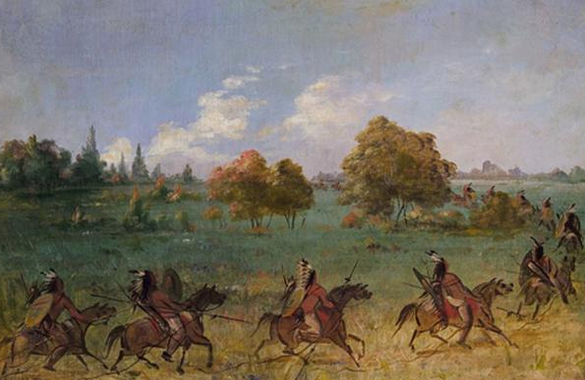Apachies: Apache tribe creation story -The US forces had codenamed Osama Bin Laden, the former leader of Al Qaeda, Geronimo due to his stubborn elusiveness. Such is the sustained significance of the Apache tribe. Their leader, Geronimo, is also responsible for popularizing the "Geronimo!" scream as people jump out of planes.
Apache is an umbrella term for several Native North American tribes. An evocative name in US history, popularized by Hollywood Westerns, the Apache included six main tribes: Chiricahuas, Jicarilla, Western Apache, Kiowa, Mescalero, and Lipan.
What is the meaning of apache?
The word "Apache" is probably a Spanish derivative of the Zuni word "Apachii" or "Apachu," meaning "enemy." Similarly, the names of all these tribes are corrupted versions of the original, local names. The term Apache and the rest of these terms came into use only after the arrival of the European settlers. For brevity, we will not discuss the specifics of each tribe here. Some people consider Navajos to be distant cousins of Apache tribes. However, since the term Apache is somewhat loosely defined, opinions differ. If the real names of these groups, which include, for example. Sagatajen-ne and Yntugen-ne seem distracting, imagine what it would have seemed to the people of the Old World discovering a new continent. They must have thought they were in an episode of the Twilight Zone!
And, what about the local populations?
Had they not been such ferocious people, they might have been scared by the invasions of these very different folk. Many Apache tribes were found in the Southwestern United States; however, their history presents an intriguing story. During prehistoric times, most of these tribes lived in the Northern Plains.
According to anthropological evidence, they made their way from the Northwest Pacific Coast to the Southwest between the 13th and 15th centuries. They did not settle in the Canyonlands as they moved eastward, instead opting for the Southern Plains of Texas, Oklahoma, and New Mexico. We know that after the migration, the Apache divided into Eastern and Western groups. This division could be a consequence of migration. As more people would have tagged along, the genetic pool of the tribe would have been subject to change. Some people think that these divisions had existed for a long time, leading to diverse groups that occupied different regions.
Whether they were diverse from the beginning or became a consequence of time, these groups spoke the languages of the Athabaskan family. As this family of languages can be found in the North, the Pacific Coast, and the Southwestern territories, they help historians evaluate the migration patterns of the Apache. The renewed interest in the subject and the evolution of archaeological techniques have helped us make significant progress in understanding these local tribes.
As witnessed in other cultures of the New World, their ideas and beliefs were far different from that of the Old World. Even in Mesoamerican cultures, it was pretty standard for people to migrate due to climate change and ecological circumstances. The Athabaskan-speaking people left behind a healthy amount of materials, goods, and dwellings for archaeologists. Increased exposure and curiosity have also contributed to the modern understanding of their culture. Almost all Apache people lived in extended families, similar to Asian households.
However, the Western Apache differed in one respect: family units followed the lineage of the females as opposed to the males. The daughter and her newlywed husband lived next to the woman's parents. Short of a few exceptions, most tribes followed this tradition. The tribes lived in tepees; they would strip the roofs of their dwellings in the summer. They hunted animals, gathered food, grew plants, and traded with other tribes.
Raiding was also a viable option for obtaining food and clothing – they mostly wore decorated animal hides. The extended families would naturally develop a hierarchy with a chief at the top. The Apache tribes had a non-traditional understanding of tribes, and groups would often engage in conflicts and wars with each other. While they had been content with fighting each other for a long time, a singular foreign force would soon threaten their survival, encroaching on their domain. The Spaniards had begun their seafaring adventures and were starting to find their footing on the new continent. The Spanish came across the Apache for the first time in the 16th century.
During the Coronado expedition of 1540, they had come across the Apache, but it was not until the late 16th century that the relationship began to turn sour. By 1610, the Spanish had colonized the region and even founded the town of Santa Fe. When the Apache initially arrived in the Southwest, they developed an excellent commercial relationship with the Pueblos. The Puebloans were native Southwestern tribes that built permanent structures. The Spanish found Pueblos in New Mexico and Arizona.
Although the Apache were not entirely nomadic, they differed from the urban-minded Pueblos. The average Apache dwelling took only three days to make, and they were among the first native tribes to start riding horses. These characteristics allowed them to adopt an increasingly nomadic lifestyle. Although varied, the two sets of tribes enjoyed a pleasant correspondence. The Spanish wanted a piece of the action, and by sowing seeds of discontent, they created divisions in the tribes. Some Eastern tribes colluded with the Europeans and migrated to northern Mexico and Texas. The Spanish would eventually enslave these people and use them as free labor.
Apache goddess
However, the relationship between the locals and the foreigners was complicated. Native bands could be on friendly terms with some groups of colonizers and at war with others, and vice versa. However, the Apache bid to become friends with Spanish, Mexicans, and Americans failed as the Europeans began to make religious headway. During a drought in the 17th century, the Spanish could not protect the Pueblo villages from the Apache. The Spanish had continued their missionary work, but a five-year drought and incoming raids did not instill confidence in their God. This issue resolved itself in the form of the Pueblo Rebellion of 1680.
Afterward, some Pueblos would end up taking solace with Navajos. The Apache's relationship with the Spanish had been deteriorating for a while. As the Spanish continued their missionary work, they attracted different tribes and bands with their teachings. The naïve idealism of the Spanish missions had them believe that they could be friends with everybody. This proposition was undoubtedly misguided. The tribes and groups maintained their rivalries with each other, so the Spanish could not have allied with one without alienating another. In the 18th century, the Spanish missions, especially Santa Cruz de San Saba and San Lorenzo de la Santa Cruz, would fail in the face of raids and hostilities. Soon, the Apache came across another dangerous foe: the Comanche.
Today, people might best remember the Comanche for the Cynthia Ann Parker story, later adapted for film by John Ford. "The Searchers" – still considered a great, albeit politically problematic, Hollywood production – starred John Wayne, who set out to rescue a girl abducted by the Comanche. This depiction is just one example of Comanche in popular media. They were a fierce group of the Frontier Era and were villainized in many Western-themed films and programs.
By the mid-18th century, guerilla tactics were on full display, and the Comanche disintegrated the Apace tribes throughout the land. The Comanche forced the Eastern Apache to move away from the Southern Plains, forcing them to collude with previously hostile groups for their survival. Most of these groups ended up in New Mexico. In 1786, the Spanish signed a treaty with the Comanche, and the two sides began hunting for various Apache tribes in the region.
By the end of the 18th century, they had rid the Southwestern plains of the Apache tribes. The capture and forceful agreement to remain peaceful allowed the region to settle down. In 1821, Mexico gained its independence, and by the 1840s, US-Mexican animosities were building up. Following the US annexation of Texas from Mexico in 1845, the two countries went head-to-head in the Mexican-American War.
Mexico considered Texas a rebellious state, whereas the Texans perceived themselves as sovereign. After their tete-a-tete with the Mexicans, the Apache decided to join the US, allowing safe passage to the US soldiers through their lands. However, the Americans were neither as shrewd nor as nuanced as the Spanish. Instead of exercising patience, they decided to jump head first and exert their authority over the lands.
Once Mexico ceded the ground, an uneasy peace with the US already had everybody on edge. This situation lasted until the 1850s, when American settlers, arriving in the region in hopes of gold, drew the ire of the Apache, giving birth to the Apache Wars. The Apache Wars were a series of conflicts in which the American gold miners who settled in the area came into direct conflict with the local tribes. The settlers had enforced their authority on the land. Ranches, livestock, and mines were emblems of their continued existence in the area. Even though the government had agreed on a settlement with the local Apache, settlers kept coming.
The Apache were initially peaceful toward these settlers, even if some tribes maintained their hatred for each other. As the Americans hoarded land, raiding parties eventually began targeting them. The situation became increasingly hostile until one day, the settlers wrongly accused Cochise, a native leader, of abducting a young boy. They took Cochise and his party hostage, upon which the allied tribes and groups surrounded the Americans.
The tribes people captured a few people, but they killed them when the Americans failed to release the captives. The Americans killed their prisoners in retaliation, too – however, Cochise had escaped. The war began in 1849, and the American forces went on search-and-destroy missions. Even though the natives knew the territory well, they could not keep up with the advanced technology and strategies of the Americans. The latest weaponry and forward-thinking tactics would prove far too much for the tribal Apache.
The Apache suffered their final defeat in 1886, when the American troops forced Geronimo, the Apache leader, to surrender.Geronimo, however, wasn't simply the caricature of the western United States that later Americans created. He was a living, respiratory man with a proud Apache background. In many ways, Geronimo and his Apache followers were the last stand against Western expansion. The Apache were known to be fierce warriors and Geronimo was among the most powerful – so it should be no surprise that he oversaw some of the last great uprisings against the growing political system of the u. s. government. His unimaginable resistance would be loved by friend and foe alike.
The Navajos had surrendered in 1863, and other groups had followed suit in the early 1870s. Some refused to give up their traditional way of living and kept carrying out raids in the following years. In the 19th century, the US government would initiate programs for "assimilating" the tribes into white American families. Soon after that, many Apache families settled down in Mexico and the United States. Today, the largest Apache populations can be found in Oklahoma, Arizona, California, and New Mexico.







0 Comments
Chat with InfoWite!